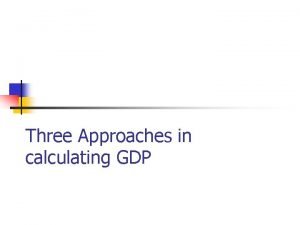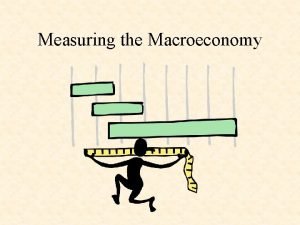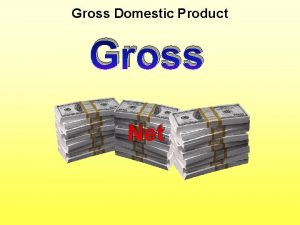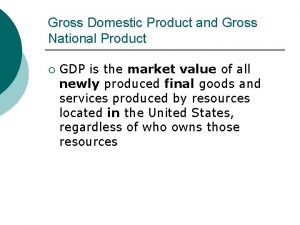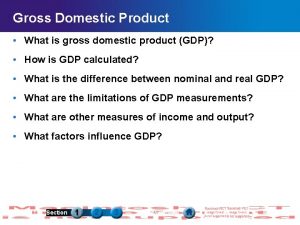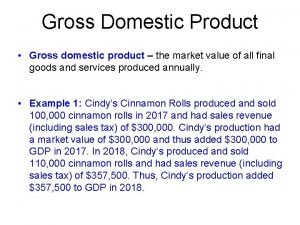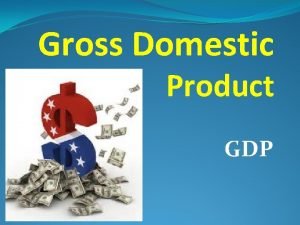Measuring the Macroeconomy Lecture 2 Gross National Product










- Slides: 10

Measuring the Macroeconomy Lecture 2

Gross National Product � The market value of the goods and services produced within a given period by nationals (residents of a nation). It includes the income earned by nationals abroad. It does not include income earned within the country by foreigners � Income earned by Poles working in London a part of Polish GNP, profit earned by a Japanese owner of Toyota in Wałbrzych part of Japanese GNP � How to avoid double counting (cars + tiers = other parts, materials? ) � Counting of value added of each firm only � Value added = firm’s sale minus the value of materials it buys to use in producing its products � Final goods and services = those purchased by their final users � GNP = value of final goods and services � Value of output not sold through market should be estimated (value of services homeowners receive from living in their houses) � But volunteer services, value of housework and do-it-yourself not included � Illegal activities excluded as well (grey or underground economy) � How big it is? Could be 25%?

Gross Domestic Product �The total income earned domestically. It includes income earned domestically by foreigners. It does not include income earned by domestic residents abroad. �Some examples: a Ukrainian worker income earned in Poland part of Poland GDP (earned domestically) but not the part of Polish GNP (worker not a Polish national). �The difference between GNP and GDP in most cases rather small. GDP more frequently used as a measure �How to estimate the value of services produced by government not sold through market (defense, police, public education)? �Usually value of public goods = wages paid to public employees

How to calculate GDP(Begg, Fisher, Dornbush) Good Seller Buyer Steel producer Value added Final goods Income of labor and capital Machines 1 000 producer 1 000 - 1 000 Cars producer 3 000 - 3 000 Machi nes Machines Cars producer 2 000 1 000 2. 000 1 000 Tiers producer Cars producer 500 - 500 Cars producer househol d 5 000 1 500 Total transa Transact ions value 11 500

The circular flow �GDP = Y (incomes of households) �Y = C + I �Y = C + S �S = I �I and S equal 2 000 (closed economy, no government) �GDP ( market prices)= C + I + G (expend. for final goods �Y=GDP ( base prices)= (C+I+G)-Te (indirect taxes) �Personal disposable income=Y+B(transfers)-Td (direct taxes) �Y=C+I+G+X-Z-Te (open economy, X=Exports, Z=Imports

Personal Income �An income that households and non-corporate businesses receive �Personal Income=National Income �- corporate profits (retaining earnings + dividends + taxes) �+ transfers (such as social security and welfare benefits) �+ social insurance contributions �+ dividends �+ personal interest income (the interest that households earn) �Disposable Personal Income = Personal Income – Personal Tax and nontax payments

Nominal and Real GNP output Price $/unit Value of output, current $ Value of output, 1982 ( $) Value of output 1982 ($) 1982 1989 Cars 100 150 2 4 200 600 200 300 meat 100 140 4 6 400 840 400 560 600 1440 600 860 Nominal GNP Real GNP

The GNP deflator �Distinction between real and nominal GNP = one of most widely used measure of inflation �GNP deflator = the ratio of nominal GNP to real GNP expressed as an index �GNP deflator for 1989 = (1440/860) x 100 = 167, 4 �Prices increased 67. 4% between 1982 -89 �Nominal GDP=real GDP x GDP deflator �Nominal GDP measures the dollar value of the output �Real GDP measures the amount of output, the output valued at constant (base year) prices �The GDP deflator measures the price of the typical unit of output relative to its price in the base year

The consumer price index �The most popular measure of the level of prices �CPI turns the prices of many goods and services into a single index measuring the overall level of prices �C PI the price of a basket of goods and services relative to the price of this basket in a base year �CPI tells us how much it costs now to buy the basket relative to how much it cost to buy the same basket in a base year �The producer price index measures the price of typical basket of goods bought by firms

C PI and GDP deflator �GDP deflator measures the prices of all goods and services produced, CPI prices of goods bought by consumers �GDP deflator includes goods produced domestically, prices of imported goods do not show up �C PI assigns fixed weights to the prices of different goods, GDP deflator assigns changing weights (allows the basket of goods to change over time)









